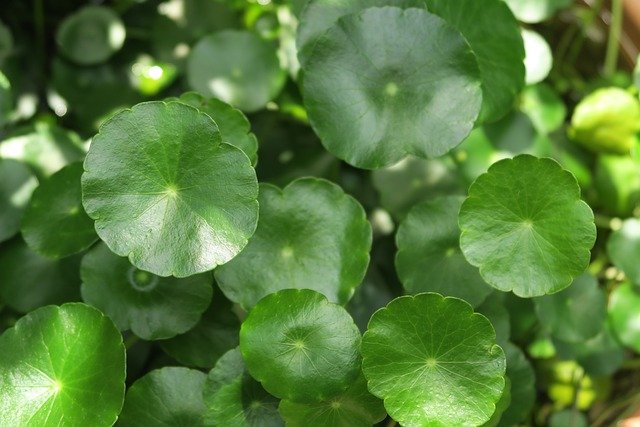Benefits of Indian Pennywort (Thankuni) Leaves
Indian Pennywort, commonly known as Thankuni, is a well-known herb that grows on the edges of fields, ponds, or damp areas. It has been used since ancient times for its medicinal properties and benefits for health and beauty. Here are some of the key benefits of Indian Pennywort leaves:
Medicinal Benefits:
- Healing Skin Wounds:
- Indian Pennywort leaves can stop bleeding from cuts and wounds. Crushing and applying the leaves to the wound relieves pain and stops bleeding.
- Maintaining Blood Flow:
- The juice of Indian Pennywort leaves purifies blood, ensuring oxygen-rich blood reaches every cell in the body, which helps with various physical complications including thrombosis.
- Relieving Body Burns:
- The madecasside in Indian Pennywort relieves skin irritation, cools, and soothes the skin from within by controlling skin temperature, providing freshness.
- Preventing Ulcers:
- Indian Pennywort leaves are useful in preventing stomach diseases like dysentery and ulcers. Regular consumption can also ease digestive problems.
- Relieving Mental Fatigue:
- The juice of Indian Pennywort leaves is effective against mental depression, regulating stress hormones, alleviating anxiety and stress.
- Increasing Brain Performance:
- Regular consumption of Indian Pennywort leaves boosts levels of antioxidants and pentacyclic triterpenes in the body, improving memory and cognitive function.
- Improving Sleep:
- Drinking water soaked with Indian Pennywort leaves can help relax the nerves and improve sleep quality.
Beauty Benefits:
- Enhancing Skin Freshness:
- Rich in antioxidants and high-quality amino acids, Indian Pennywort leaf extract helps keep the skin fresh and vibrant by reducing tiredness and acne breakouts. It also helps remove acne scars due to its antibacterial and anti-inflammatory properties.
- Preventing Skin Aging:
- Flavonoids and madecasside in Indian Pennywort act as antioxidants, protecting the skin from premature aging caused by pollution and sun rays. It also boosts blood circulation and collagen production, which helps prevent wrinkles and increases skin elasticity.
- Maintaining Skin Moisture and Softness:
- Amino acids, beta carotene, fatty acids, and phytochemicals in Indian Pennywort help retain skin moisture and supply essential nutrients, keeping the skin soft and reducing signs of aging.
- Preventing Hair Loss:
- Indian Pennywort extract is often used in anti-hair loss products. Its anti-inflammatory properties improve blood circulation to the scalp, promoting healthy hair.
Additional Benefits:
- Boosting Immunity:
- The high vitamin C content in Indian Pennywort leaves enhances immunity, helps with mouth sores, and is beneficial for colds.
- Treating Stomach Ailments:
- Indian Pennywort juice is effective for stomach ailments including dysentery, cough, and sore throat due to its herbal properties.
Indian Pennywort is a versatile herb with numerous health and beauty benefits, making it an invaluable addition to both traditional and modern medicinal practices.
Container Size:
- Choose small, medium, or large tubs of any size, or any suitable pot.
- Ensure the tub has 2-3 holes at the bottom to prevent waterlogging.
- Place sand and bricks at the bottom to facilitate proper drainage.
Soil Preparation:
- Indian Pennywort can grow in almost all soil types, but loam or sandy loam soil is ideal.
- Mix organic manure and cocopeat into the soil for better growth.
- Prepare the soil well before planting in the tub.
Planting Time:
- Indian Pennywort can be cultivated year-round, but summer is the best time for seed collection.
- Seeds or roots can be planted in tubs at any time of the year.
Seedling or Seeding Method:
- Indian Pennywort flowers in spring and its fruits ripen in summer.
- Propagation can be done by seeds or vegetative propagation.
- Roots emerge from each node of the creeper. Planting a creeper with roots in the tub allows Indian Pennywort to grow effectively.
- Ensure that water does not accumulate in the tub, as Indian Pennywort cannot tolerate waterlogging.
- Avoid overwatering.

Care:
- Ensure the plants receive regular sunlight.
- Apply fertilizer as needed.
- Spread a handful of vermicompost and mix it into the soil after one month of planting.
- Harvest the leaves regularly to encourage growth.
- Keep the tub free of weeds.
- Prune the plants when they become too thick to promote healthy growth.
By following these guidelines, you can successfully grow Indian Pennywort in tubs, ensuring a steady supply of this beneficial medicinal plant.

